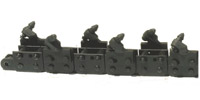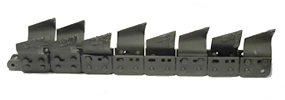UTI In The
News > |
Published Articles > |
Picking the Correct Cutter System |
|
|
Picking the Correct Cutter System
 Dig with Efficiency — Match
Your Trencher Chain to Your Attachment and Application Dig with Efficiency — Match
Your Trencher Chain to Your Attachment and Application
By Tim Passon
At first glance, all trencher chains might look pretty
much alike. They all boast round rollers, round pins,
bushings and rectangular side plates made of steel. But
when it comes to choosing a chain for your compact trencher
attachment, not all chains are created equally.
Only a closer examination can reveal
the quality construction in a chain. The quality of
steel, for instance, will have a direct impact on the
hardness achieved during the heat-treat process. Component
parts that are broached, instead of stamped, will have
a considerably better fit — and
subsequently add to chain life. Attachments generally
come with either a 34,000- or 50,000-lb tensile strength
chains.
Of course, it’s virtually impossible to evaluate
the quality of a bare chain just on looks alone. This
is not to say the quality “look” of the bare
chain is not important, because it is, but what’s
even more important is application — choosing the
correct cutting system that matches the conditions you
plan to trench. Generally the manufacturer has already
chosen a chain that will best match the power of the
compact trencher attachment, but will it match the application?
It’s best to shop around and
ask questions about the chains and their intended applications.
Below are some of the most  common cutting systems available: common cutting systems available:
1. Cup Cutter
The cup cutter chain is the original cutting system
and has been around since the 1950s. It is still the
most efficient way of digging in soft to medium soil.
2. Welded Scorpion or Shark Chain
A
welded Scorpion Chain is a great chain in almost any
condition with the benefits best felt in hard ground.
Sometimes referred to as “the throw away chain” because
the cutters will remain productive for the life of the
chain.
3. H-Plate
The Welded H Plate chain is effective in hard rocky
conditions. The conical style cutters are replaceable.
H-Plate is definitely for the toughest ground conditions.
4. Bolt-on Scorpion
The Bolt-on Scorpion is also a great chain in rocky
and hard soil. The bolt on feature allows the flexibility
to change the width of cut.
5. Bolt-on Alligator
The Bolt-on Alligator is also a great chain in
rocky and hard soil. The bolt on feature allows you to
change widths and the conical style bits are replaceable.
As you can see there are quite a variety of cutting
systems. In recent years the mixed or combination chains
have also become quite popular. The fact is that no matter
how well you know your digging conditions, you are bound
to encounter unexpected veins of hard ground. By mixing
an Alligator or a Scorpion with cup cutters you can be
better prepared for those unexpected tough conditions.
The carbide will break up the soil and the cup cutters
will help assist in the clean out of the trench.
As mentioned earlier, there is not one
system that best suits each digging condition. However,
if you are in it for the money, regular chain maintenance
is a must. When it comes to chain maintenance, Underground
Tools Inc. (UTI), manufacturer of a wide range of wear
parts and chains for the underground construction industry,
recommends the SAVE method.
1 . Sharp Cutters:
There is no substitute for sharp cutters. Anyone who
has ever used a chainsaw can appreciate the difference
sharp cutters make. When you saw through a log with sharp
cutters, you will notice the saw does the work and not
you. As the cutters become dull, you do more work than
the saw. The same holds true for the trencher attachment.
As the cutters dull, the attachment requires more horsepower
and you are wearing out your machine just like you would
your body. Cutting with dull worn out cutters is by far
the greatest expense you will encounter.
2 . Always put a new sprocket
with a new chain: The chain is designed to run on sprockets
of the same pitch. As a sprocket wears the teeth become
deformed. Consequently, they no longer are the same pitch
as the new chain you just installed. This will cause
elongation of the chain, which will rob you of service
time. Typically a new sprocket will cost less than 10
percent of the price of a chain, but will add 15 to 20
percent to the life of the chain. In addition, new sprockets
will enhance machine performance and eliminate extra
wear and tear on other components, translating to overall
cost savings on the job.
3. V- Pattern:
Over the life of a chain, cutters will wear out or
break, or maybe a change has been made to the cutting
systems width. It’s been said many times before — “No
problemo, just take off a couple cutters here and add
a wider cut there and you will be good to go.” WRONG! Think
about digging a hole through sod in order to plant a
tree. Would you use a shovel or would you use a spade?
Of course you would use a spade. The same holds true
with a trencher.
By indiscriminately replacing worn out cutters or adding
cutters here and there, you have changed your system
from a spade to a shovel. You are asking for lost productivity
and added wear to other components of your machine. The
best advice is to do the right thing and disassemble
and then reassemble you chain with a proper V-shaped
pattern. Typically, it is best to have a cutter slicing
in as many places as you can, especially in hard ground.
A pattern should graduate from center cut to your desired
width in increments of 1 to 2 in., depending on the severity
of the ground conditions. Your local dealer should be
able to provide you with a pattern outline to assist
you in assembling the best V-pattern for your conditions.
4. Experience: Like anything
there is no substitute for experience. Experienced operators
understand that all conditions are not best suited for
all out chain speed. Matching chain speed to ground speed
is essential for peak performance and productivity. Cutting
angle, speed, depth, ground speed and volume are all
performance enhancing opportunities that come with experience.
Over tightening of a chain will not only promote wear,
but it will also rob your attachment of valuable horsepower.
The rule of thumb for chain tension is, while the boom
in extended in a horizontal position, adjust the chain
to sag approximately a distance equal to the pitch of
the chain (pitch is the center of the rivet to the center
of rivet on the chain).
In short, choosing and then maintaining the right cutting
system for your trencher attachments is of utmost importance.
And though many trencher attachment chains look alike,
each one is engineered for an individual task. Generally
the manufacturer has already chosen a chain that will
best match the power of the compact trencher attachment
you own, but depending on your various applications,
you may need more than one. And with companies like UTI
selling chain and cutting systems for the last 30 years,
you are guaranteed to find the exact trencher chain to
give you added performance while not emptying your pocketbook.
Tim Passon is the co-owner of
Underground Tools Inc., St. Paul, Minn.
|

 Dig with Efficiency — Match
Your Trencher Chain to Your Attachment and Application
Dig with Efficiency — Match
Your Trencher Chain to Your Attachment and Application common cutting systems available:
common cutting systems available: